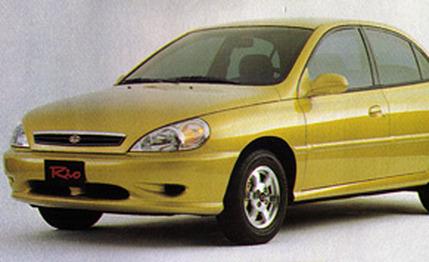
 First Drive Review
First Drive Review
As mission statements go, the one Kia Motors has devised for doing business in North America may be the simplest: Go into big-volume segments and sell a product for less than any other automaker does, and-oh, yeah-work as hard as you can to improve quality.
So the Rio subcompact should be out about now, a mid-size sedan will debut this fall and show up next winter, and the 2002 Sedona minivan will arrive next spring or summer, and all of them should have higher quality than the models currently for sale.
This corporate attitude won't do much to get the attention of enthusiasts, but people in need of inexpensive transportation will undoubtedly pay heed since their low-end choices will increase significantly.
At the low end of that economic totem pole is the Rio, which is pretty much a generic starter sedan with its "Power Round Design." This model does not offend, but neither does it excite. It just is. Its station-wagon sibling has a certain amount of funky charm, but for the moment it's not on the U.S. dance card.
The Rio is commodious for a little car, and Kia has cleverly made it easy for people to adjust the seats to their liking and set them as high as possible so you don't feel as if you're sitting in a sled. This somewhat helps reduce the feeling that you're in the smal lest vehicle on the road (it's 56.7 inches high, and with a five-speed, it weighs 2250 pounds), but only somewhat. This is a small car, and given the ongoing buyer preference for trucks, it will get smaller every day.
But the Rio is at least kind of fun to drive, thanks largely to the DOHC 16-valve, 1.5-liter in-line four with its iron block and aluminum head. If you stay with the five-speed manual shifter that comes standard with every model, you can squeeze a little pleasure out of its 96 horse-power and 98 pound-feet of torque by keeping the revs up near their max points-5800 and 4500 rpm, respectively. Pay more for the electronically controlled four-speed automatic, and it's not as easy to tap into that juice.
The front suspension is independent, with struts, coil springs, and an anti-roll bar. There's a torsion-beam axle at the back that Kia likes to call "elegantly simple." With the rack-and-pinion steering, you can toss a Rio around a bit, but it seems unlikely many people will do that.
Most folks will go to the Rio for its value, since it will probably start at about $9000. It won't have a lot of equipment, but what it will have is covered by a basic limited warranty good for 36 months or 36,000 miles and a powertrain warranty good for 60 months or 60,000 miles.
The Rio will have two upgrade packages. You need either upgrade for speed-sensitive power steering and "upgrade 2" to get the tilting wheel. Free-standing options include A/C, a pair of audio systems, alloy wheels, and anti-lock brakes. Rio pricing isn't available yet, but these options, with the CD player, would add $2775 to the price of a 2000 Sephia.
During our visit to various Kia facilities around Seoul, South Korean officials said little about the upcoming mid-size sedan. One executive admitted that it would use the Sonata platform from Hyundai, which controls Kia, and that it is currently called the Optima.
They were more forthcoming about the Sedona minivan, of which they hope to sell 50,000 a year in the U.S. The Carnival, as it's called in Korea, cuts a pleasing figure, and it could be the only minivan in this country with a hood scoop, but that's not certain. What is certain is that it will have a unique twist to its two-two-three seating configuration-middle seats that recline and rotate to face backward.
It will also have considerably more oomph when it crosses the Pacific, since Kia plans to drop a Hyundai-built 3.5-liter V-6 under that scooped hood. Exact details and performance figures are unavailable, but this powerplant should flirt with 200 horsepower in its North American configuration. We couldn't test that engine, but a Carnival with a 2.5-liter V-6 did a commendable job of hauling five full-size (and then some) British and American journalists around a test track at a steady 100 mph. It was rock solid and nimble, surprisingly quiet, and comfortable for all involved. With a price close to that of a mid-size sedan, this minivan could hold considerable charm for those looking for a people and cargo hauler.
As for that quality, a Kia executive said the company hopes to get its "things gone wrong" scores down from 350 per 1000 vehicles in 1999 to 270 in 2000 to 200 in 2001, which would put them only slightly behind the industry average.